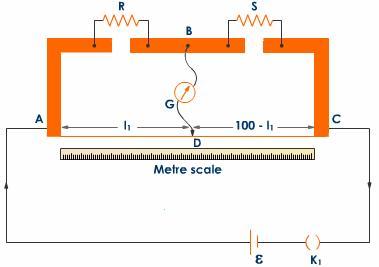sir can u guidee me whether post office box and multimeter concept is imp for JEE or not ?????[12]
Explain the experiment to find the specific resistance of the material of a wire using meter bridge.
(Very IMP for IIT JEE)
-
UP 0 DOWN 0 1 8

8 Answers
yes it is important for JEE as well subash.
Each year they do give 5-10% weightage to the experimental physics part!
I dont think post office box or multimeter are very important.
but the experiments based on them are very important.
YOu should kow the working of post office box though.
Multimeter as such is not useful for IIT JEE.. Only that it gives some value :)
resistivity cld be find out by using Ï=X Ï€D2/4l
whr X cld be find out using meter bridge,'D' ie diameter of the wire cld be find out by usning screw gauge and length of wire cld be find out using a simple scale
 Metre Bridge
Metre Bridge
This is the simplest form of wheatstone bridge and is specially useful for comparing resistances more accurately. The construction of the metre bridge is as shown in the below figure.
It consists of one metre resistance wire clamped between two metallic strips bent at right angles and it has two points for connection. There are two gaps; in one of them a known resistance whose value is to be determined is connected. The galvanometer is connected with the help of jockey across BD and the cells is connected across AC. After making connections, the jockey is moved along the wire and the null point is obtained. The segment of length l1 and (100-l1) form two resistances of the wheatstone bridge, the other two reistances being R and S. The wire used is of uniform material and cross-section. The resistance can be found with the help of the following relation
R=S* l1/100 - l1
where s is the resistance per unit length of the wire and l1 is the length of the wire from one end where null point is obtained. The bridge is most sensitive when null point is somewhere near the middle point of the wire. This is due to end resistances.
so basically what we are trying to do is create a balanced wheatstone bridge....
@honey... well what you have written is correct. but is not relevant to this question..
Here we are trying to understand it from experimental physics.